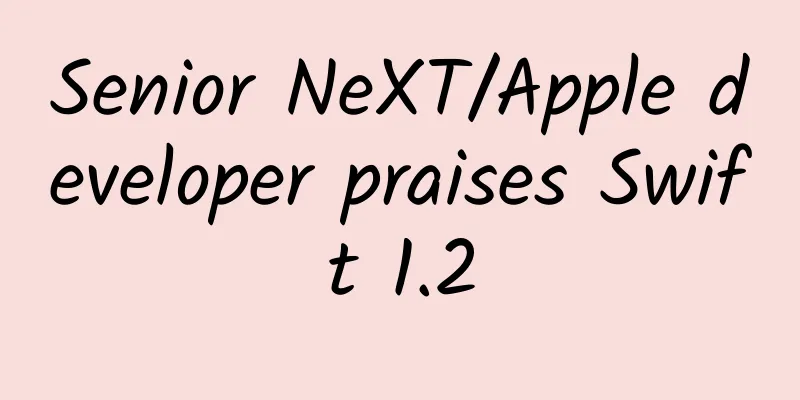How to effectively collect user feedback in mobile apps

|
This article analyzes various mainstream feedback forms in mobile applications from multiple dimensions such as user experience, development, operation and maintenance, and cost, and deeply analyzes the applicable scenarios of each feedback form. The purpose is to help mobile application development teams use feedback mechanisms more reasonably and improve products. 1. The Importance of Obtaining User Feedback in Mobile Apps According to the lean principle, developing a mobile application should be a small-step iterative process of "design-development-launch-feedback-modification-redesign", so as to ensure the development of a successful APP at the lowest cost. User feedback is an indispensable part of the product life cycle and an important basis for determining the direction of the APP. Brian Harry writes about the importance of collecting user feedback in software: “Feedback helps you clarify your understanding of yourself. Feedback helps you see the world in a new light. Feedback helps you correct your course. Feedback helps you learn. Feedback makes you and your work better. Whether or not you follow a particular agile development practice, early and frequent feedback is one of the most important factors in making you more successful.” Similar to traditional website applications, there are two main ways to obtain user feedback in mobile applications: direct feedback and indirect feedback. Direct feedback is to encourage users to directly express their ideas by providing questionnaires, pop-up boxes, etc. Indirect feedback is based on user usage habits, indirectly obtaining valuable information, such as analyzing interface jump processes, page dwell time, button click frequency, user retention, active cycle, etc. This article only discusses the first one. There are many forms of direct feedback. Email feedback hidden in "Settings" is often too hidden and lacks context, which makes users feel overwhelmed. The need to enter a large amount of text information on a small mobile phone screen is also a big limiting factor; long questionnaires are daunting for users; and frequent pop-up boxes drive users crazy. At the same time, Alex Adamopoulos analyzed the cost of feedback in "The Problem with Feedback". He believes that the introduction of any feedback mechanism requires the team to pay a corresponding cost. Therefore, how to measure whether the embedded feedback loop has brought matching economic benefits and how to maximize the value of the feedback loop have become issues that the team has to consider. In terms of cost, in order to reduce the design, development, operation and maintenance costs required for the introduction of the feedback mechanism, there are also many third-party services on the market, such as the Dandelion SDK. When choosing the most suitable feedback form for their mobile products, product managers, designers, and developers often face some challenges, such as: How to choose from multiple feedback forms? Should they develop it themselves or choose a third-party service? What should the team do before, during, and after feedback? Can the existing team capabilities meet the requirements? Can they afford the design, development, and operation and maintenance costs involved in the feedback module?
Starting from the feedback timeline, this article helps product managers, designers, developers, etc. understand what issues should be considered when adding a feedback module to a mobile app, as well as the characteristics, applicable scenarios, development and operation and maintenance costs of different feedback forms, etc., to help everyone make the most wise choice, so that the small feedback module can play the greatest role and truly contribute to the success of the product. 2. Before getting feedback 1. Clarify your goals The product manager should be very clear about what type of software the APP is, what stage it is in, and what kind of feedback needs to be collected from users. Let's take two of the most common examples: Business apps, such as banking or insurance, focus more on the business itself, and in most cases want to know whether users are satisfied with the newly launched business. Tool apps focus more on the user's experience of functions and design. For example, after Uber entered the Chinese market, it wanted to know whether the app's functions and interactive design met the Chinese people's usage habits. After real estate apps added a "favorites of managing your favorite properties", users wanted to know whether it really brought convenience during use. 2. Consider the cost Project managers should be very clear about the impact of different types of feedback, such as which roles need to be involved, what capabilities each has, how long it will take, etc., in order to calculate costs, organize teams and arrange delivery plans. The feedback module mainly involves three parts of work: the first is to design and develop the APP as the entry point for users to input feedback content; the second is to design and develop a background system for administrators to view and manage feedback data; the third is manual processing and analysis of large amounts of collected data, as well as interaction with users. The costs involved are mainly reflected in:
3. Determine the feedback format Common forms of feedback in mobile applications are as follows: (1) Email method: users open the email client from the APP and express their feedback by writing emails. The biggest advantage of this method is low cost. The interaction is simple and does not require additional design. In terms of development, it only takes a few lines of code on the APP side and does not require background support. At the same time, the user's email address can be directly obtained, which is convenient for replying, so it is conducive to the maintenance of customer relationships. Considering that in most cases, users who can actively choose this method to provide feedback are often more loyal users, it is most likely to collect valuable data, or even unexpected ideas. The disadvantages are mainly in the following aspects: lack of context, need to leave the APP, which may cause user loss; the collected feedback is scattered in the mailbox, which is very inconvenient to view, track, and analyze data. It is suitable for situations with limited budget, short development time requirements and limited development team capabilities (usually without backend development capabilities). (2) Make a small choice before the user gives feedback Do they "like us" or "want to complain"? If it's the former, we will guide users to give a five-point rating and write a good review on the App Store; if it's the latter, we will design a simple and universal feedback form in the APP, allowing users to send text, pictures and other information to the designated background. (Taobao APP) “Good news doesn’t travel far, but bad news travels a thousand miles.” There is a term in psychology called “negative bias.” Compared to positive information, our brains usually have a stronger and more lasting reaction to negative information. Theoretically, we are more susceptible to negative news. This method can not only obtain feedback, but also greatly increase the rate of positive reviews of the APP, while minimizing the impact of negative reviews. Compared with the email method, the biggest advantage is that all feedback results can be managed uniformly in your own background, which is convenient for viewing and tracking the status of feedback. In the upcoming iOS 10.3, Apple will allow users to rate and comment on apps, which will be automatically synchronized to the App Store. This will eliminate the need for users to leave the app to comment, greatly reducing the rate of losing users due to comments. At the same time, iOS 10.3 will also allow developers to publicly respond to comments in the App Store, strengthening stickiness with users. This shows how much Apple values the closed loop of feedback between developers and users. Of course, this also brings additional costs, mainly reflected in the development of the background management platform, which requires the team to have the ability to develop websites. A background that includes the most basic data display, classification, report analysis, status tracking and other functions requires at least half a month of development work by a senior website development programmer. (Except for those who choose third-party services) Suitable for situations where the budget is sufficient and the team has the ability to develop websites. (3) Questionnaire (WeChat APP) Since emails and general feedback forms are too versatile, it is difficult to obtain valuable information in a targeted manner unless the user is very clear about what they want to express; at the same time, a large amount of text needs to be manually entered, which is very inconvenient to operate on a mobile phone. It is difficult to quickly classify the collected feedback data. Therefore, a smarter way is to use a questionnaire, which lists a series of targeted questions in advance and allows users to operate conveniently by checking the boxes. Not only is it easy to operate and easy for users to accept, but it can also obtain answers to specific questions very efficiently. At the same time, it is easier for the background to perform statistical analysis on the results. This method requires you to determine the points that urgently need to collect feedback at this stage in advance, and then design the questions and forms. If the questions are too long, it is easy to cause users to reject them. Designing forms and questions is a relatively deep subject. The principle is to obtain the maximum amount of information through the least amount of questions, so it has high requirements for product managers. In terms of development, you can embed web-type forms similar to Golden Data, which can not only greatly reduce the development costs of the front-end and back-end, but also provide powerful background data analysis functions. (4) Feedback in the form of multimedia including pictures (screenshots), voice, and text (Dandelion SDK) Since text-based feedback can cause a lot of inconvenience to users when describing some complex scenarios, more and more apps now use screenshots, annotations on screenshots, and combined text and voice feedback. Users can easily express their ideas at any time and in any interface, greatly increasing the probability of users actively providing feedback. In order to make the screenshot operation faster, in addition to the system's native screenshot, many apps support the "shake" function to trigger the screenshot. The biggest advantage of the screenshot feedback design is that it does not take up any screen space and can be widely adopted. The disadvantage of voice feedback is that the operation and maintenance cost is high, and a large amount of collected voices need to be manually analyzed and classified. One way to reduce the operation and maintenance cost is to perform voice analysis on the APP side, that is, after the user inputs the voice, it is converted into text information before sending it, which is equivalent to leaving the analysis work to the user, which will greatly reduce the user experience. Since sending voice on a mobile phone has requirements for the user's scenario, voice feedback is usually mixed with other types of feedback to allow users to choose. (5) Context-based feedback combined with NPS In order to achieve a balance between user experience and feedback effect, as an extension of the concept of Design in Context, we recommend the use of a context-based feedback mechanism, that is, to determine the form, content, entry, and frequency of feedback based on specific scenarios and specific users. NPS (Net Promoter Score) is a commonly used method to judge user loyalty. Through a short question "Will you recommend this product to your friends?", users are divided into three categories: "Recommenders", "Passives", and "Detractors". Then continue to ask "Recommenders" more in-depth questions, truly achieving "getting more valuable information from users who are most likely to provide feedback without annoying ordinary users". Therefore, it is a method we prefer. After a user has used a feature multiple times, first use NPS to get the user’s preference for this feature; then based on the user’s answer (like or dislike), ask a few more targeted questions, while ensuring that the feedback module has a friendly design (pop-up boxes, which are very intrusive, should be avoided). This method can collect a large amount of targeted and valuable feedback data in a short period of time, and is particularly suitable for use within a period of time after a new function is launched. (Airbnb) 3. Collecting feedback 1. Respond to user feedback promptly Now that APP has successfully integrated the feedback module, the product manager's job has been expanded: constantly checking the mailbox or the backend feedback data management system to obtain first-hand user feedback information. However, just "looking" is far from enough. Whether the user's feedback is good, constructive, or critical, they have spent their own time and energy, and they will also want to know whether their feedback has been seen and valued. Therefore, timely replying to user feedback is a crucial step to improve user satisfaction. The first is to inform the user as soon as possible after receiving the user feedback, and to deal with it in time, and to express sincere gratitude. The second is to get in touch with the user in time after analyzing the feedback content, which may be answers to the user's questions, or plans or results for dealing with their opinions. The third is that when the user's suggestions are adopted and officially launched, those users who have been waiting should be notified, so that they can not only use the APP better, but also feel the joy of their suggestions being adopted. Email communication is the least intrusive way to communicate with users, so it should be noted that any design of feedback form should consider obtaining the user's email address for subsequent tracking. Note: In order to save development costs, you can also choose to use relatively mature third-party services. Most mature third-party services not only provide a variety of APP-side feedback interfaces, but also include powerful feedback data management functions in the background, which can greatly reduce development costs. The disadvantage is that the style and function are difficult to customize, and data security cannot be guaranteed. Therefore, for teams with their own unique design requirements and high requirements for feedback data security, they should choose carefully. 2. After feedback Analyze feedback data and adjust the direction of APP "When facing feedback, we need the right attitude - embrace change and don't be afraid of rework." Therefore, the last step is to summarize, classify and analyze the large amount of feedback data collected to find problems in the product, classify and prioritize the problems. If necessary, further user surveys and interviews are needed to formulate the next development and release plan based on the conclusions. IV. Conclusion In general, adding a feedback module to an APP is not an easy task. Before giving feedback, clarify the goal, comprehensively consider the function and cost to formulate the feedback form, determine the feedback entry, timing and frequency, and then the feedback module can be successfully integrated into the APP. In the feedback, express gratitude to the user who provided the feedback in a timely manner and inform them of the latest progress at any time. After giving feedback, conduct big data analysis on the feedback results to effectively adjust the further direction of the product. Only by taking each step steadily can the feedback module really play a role and make users like your product more and more. [This article is an original article by 51CTO columnist "ThoughtWorks", WeChat public account: ThoughtWorks, please contact the original author for reprinting] Click here to read more articles by this author |
<<: Android sliding analysis and various implementations
>>: Computing power on data platforms: Which GPUs are better suited for deep learning and databases?
Recommend
Weilai CEO Li Bin: Only 4% of trips exceed 100 kilometers, and electric vehicles are absolutely sufficient for daily use
Recently, at the 18th Annual Conference of Chines...
WeChat Mini Programs are popular. I have summarized the 4 best ways to learn mini programs by yourself in terms of product and operation.
With the public beta release of WeChat Mini Progr...
How to promote and operate WeChat mini programs? What are the ways to promote WeChat mini programs?
It has been more than 5 years since the mini prog...
The Sun family of the Three Kingdoms: Tears in my eyes, the imperial seal has ruined their lives!
Mixed Knowledge Specially designed to cure confus...
Do ruminants have fewer stomach problems than humans?
I saw a very interesting question today and I wou...
There are pitfalls when it comes to selling products with influencers!
Not all live streaming sales by internet celebrit...
Chinese cartoons look like national treasures? There are so many "cultural relics" hidden in "Nezha 2"...
The domestic animated film "Nezha: The Devil...
Use 3 tricks to easily promote your product
For a large, mature company, promoting a new prod...
Be careful in the rainy season! Wading in the water after the rain may cause poison
Guangzhou has been hit by heavy rains since May, ...
Faraday Future hires former BMW electric car executive to accelerate FF91 mass production
According to foreign media reports, Faraday Futur...
User operation customer acquisition and conversion methods!
Today I will introduce to you ARGO, a user operat...
The mysterious octopus species is actually most similar to humans?
Leviathan: Compared to the soft body of the octop...
Chuzhou Mini Program Customization Company, how much does it cost to customize a travel supplies mini program?
How much is the quote for customized Chuzhou tour...
Are there wandering planets in the universe? Here's everything that "The Wandering Earth 2" didn't say
The earth itself is not a hard rock. 40-70 kilome...
3 methodologies for selling goods through live streaming!
Nowadays, the so-called sales promotion is actual...









